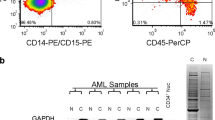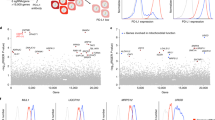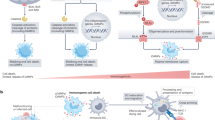Abstract
THOC5 is a member of the THO complex that is involved in processing and transport of mRNA. We have shown previously that hematopoietic stem cells have an absolute requirement for THOC5 for survival and that THOC5 is phosphorylated on tyrosine 225 as a consequence of leukemogenic protein tyrosine kinase (PTK) action. We have investigated pathways for THOC5 phosphorylation to develop an understanding of THO complex modulation by tyrosine kinase (TK) oncogenes in leukemias. We demonstrate that THOC5 phosphorylation is mediated by Src PTK and CD45 protein tyrosine phosphatase action and that this event is sensitive to oxidative status. We show that THOC5 phosphorylation is elevated in stem cells from patients with chronic myeloid leukemia (CML) and that this phosphorylation is sensitive to the frontline drugs used in CML treatment. Further we show that THOC5 Y225 phosphorylation governs mRNA binding. In addition, CXCL12 is shown to induce THOC5 Y225 phosphorylation, and site-directed mutagenesis demonstrates that this modulates motile response. In conclusion, we delineate a signaling pathway stimulated by leukemogenic PTKs, chemokines and oxidative stress that can affect THO complex mediation of gene expression describing mechanisms for post-transcriptional regulation of protein levels.
This is a preview of subscription content, access via your institution
Access options
Subscribe to this journal
Receive 12 print issues and online access
$259.00 per year
only $21.58 per issue
Buy this article
- Purchase on Springer Link
- Instant access to full article PDF
Prices may be subject to local taxes which are calculated during checkout






Similar content being viewed by others
References
Reed R, Cheng H . TREX, SR proteins and export of mRNA. Curr Opin Cell Biol 2005; 17: 269–273.
Rehwinkel J, Herold A, Gari K, Kocher T, Rode M, Ciccarelli FL et al. Genome-wide analysis of mRNAs regulated by the THO complex in Drosophila melanogaster. Nat Struct Mol Biol 2004; 11: 558–566.
Gallardo M, Luna R, Erdjument-Bromage H, Tempst P, Aguilera A . Nab2p and the Thp1p–Sac3p complex functionally interact at the interface between transcription and mRNA metabolism. J Biol Chem 2003; 278: 24225–24232.
Guria A, Tran DDH, Ramachandran S, Koch A, El Bounkari O, Dutta P et al. Identification of mRNAs that are spliced but not exported to the cytoplasm in the absence of THOC5 in mouse embryo fibroblasts. RNA—A Publication of the RNA Society 2011; 17: 1048–1056.
Katahira J, Inoue H, Hurt E, Yoneda Y . Adaptor Aly and co-adaptor Thoc5 function in the Tap-p15-mediated nuclear export of HSP70 mRNA. EMBO J 2009; 28: 556–567.
Mancini A, El Bounkari O, Norrenbrock AF, Scherr M, Schaefer D, Eder M et al. FMIP controls the adipocyte lineage commitment of C2C12 cells by downmodulation of C//EBPalpha. Oncogene 2007; 26: 1020–1027.
Tamura T, Mancini A, Joos H, Koch A, Hakim C, Dumanski J et al. FMIP, a novel Fms-interacting protein, affects granulocyte/macrophage differentiation. Oncogene 1999; 18: 6488–6495.
Pierce A, Carney L, Hamza HG, Griffiths JR, Zhang L, Whetton BA et al. THOC5 spliceosome protein: a target for leukaemogenic tyrosine kinases that affects inositol lipid turnover. Br J Haematol 2008; 141: 641–650.
Mancini A, Niemann-Seyde SC, Pankow R, El Bounkari O, Klebba-Faerber S, Koch A et al. THOC5/FMIP, an mRNA export TREX complex protein, is essential for hematopoietic primitive cell survival in vivo. BMC Biol 2010; 8: 1.
Ito K, Hirao A, Arai F, Matsuoka S, Takubo K, Hamaguchi I et al. Regulation of oxidative stress by ATM is required for self-renewal of haematopoietic stem cells. Nature 2004; 431: 997–1002.
Mancini A, Koch A, Whetton AD, Tamura T . The M-CSF receptor substrate and interacting protein FMIP is governed in its subcellular localization by protein kinase C-mediated phosphorylation, and thereby potentiates M-CSF-mediated differentiation. Oncogene 2004; 23: 6581–6589.
Pierce A, Whetton AD, Owen-Lynch PJ, Tavernier J, Spooncer E, Dexter TM et al. Ectopic interleukin-5 receptor expression promotes proliferation without development in a multipotent hematopoietic cell line. J Cell Sci 1998; 111: 815–823.
Pierce A, Williamson A, Jaworska E, Griffiths JR, Taylor S, Walker M et al. Identification of nuclear protein targets for six leukemogenic tyrosine kinases governed by post-translational regulation. PLoS One 2012; 7: e38928.
Hickson I, Yan Z, Richardson CJ, Green SJ, Martin NMB, Orr AI et al. Identification and characterization of a novel and specific inhibitor of the ataxia-telangiectasia mutated kinase ATM. Cancer Res 2004; 64: 9152–9159.
Old WM, Shabb JB, Houel S, Wang H, Couts KL, Yen C-y et al. Functional proteomics identifies targets of phosphorylation by B-Raf signaling in melanoma. Mol Cell 2009; 34: 115–131.
Li X, Brunton VG, Burgar HR, Wheldon LM, Heath JK . FRS2-dependent SRC activation is required for fibroblast growth factor receptor-induced phosphorylation of sprouty and suppression of ERK activity. J Cell Sci 2004; 117: 6007–6017.
Ringshausen I, Schneller F, Bogner C, Hipp S, Duyster J, Peschel C et al. Constitutively activated phosphatidylinositol-3 kinase (PI-3K) is involved in the defect of apoptosis in B-CLL: association with protein kinase C8. Blood 2002; 100: 3741–3748.
Copland M, Hamilton A, Eirick LJ, Baird JW, Allan EK, Jordanides N et al. Dasatinib (BMS-354825) targets an earlier progenitor population than imatinib in primary CML but does not eliminate the quiescent fraction. Blood 2006; 107: 4532–4539.
Jorgensen HG, Allan EK, Jordanides NE, Mountford JC, Holyoake TL . Nilotinib exerts equipotent antiproliferative effects to imatinib and does not induce apoptosis in CD34(+) CML cells. Blood 2007; 109: 4016–4019.
Hamilton A, Elrick L, Myssina S, Copland M, Jorgensen H, Melo JV et al. BCR-ABL activity and its response to drugs can be determined in CD34(+) CML stem cells by CrkL phosphorylation status using flow cytometry. Leukemia 2006; 20: 1035–1039.
Woodcock SA, Rooney C, Liontos M, Connolly Y, Zoumpourlis V, Whetton AD et al. Src-induced disassembly of adherens junctions requires localized phosphorylation and degradation of the Rac activator Tiam1. Mol Cell 2009; 33: 639–653.
Whetton AD, Lu YN, Pierce A, Carney L, Spooncer E . Lysophospholipids synergistically promote primitive hematopoietic cell chemotaxis via a mechanism involving Vav 1. Blood 2003; 102: 2798–2802.
Pierce A, Unwin RD, Evans CA, Griffiths S, Carney L, Zhang L et al. Eight-channel iTRAQ enables comparison of the activity of six leukemogenic tyrosine kinases. Mol Cell Proteomics 2008; 7: 853–863.
Tartari CJ, Gunby RH, Coluccia AML, Sottocornola R, Cimbro B, Scapozza L et al. Characterization of some molecular mechanisms governing autoactivation of the catalytic domain of the anaplastic lymphoma kinase. J Biol Chem 2008; 283: 3743–3750.
Siitonen T, Alaruikka P, Mantymaa P, Savolainen ER, Kavanagh TJ, Krejsa CM et al. Protection of acute myeloblastic leukemia cells against apoptotic cell death by high glutathione and gamma-glutamylcysteine synthetase levels during etoposide-induced oxidative stress. Ann Oncol 1999; 10: 1361–1367.
Griaud F, Williamson AJK, Taylor S, Potier DN, Spooncer E, Pierce A et al. BCR/ABL modulates protein phosphorylation associated with the etoposide-induced DNA damage response. J Proteomics 2012; e-pub ahead of print 15 June 2012 doi:10.1016/j.jprot.2012.06.003.
Cao C, Leng YM, Liu X, Yi YP, Li P, Kufe D . Catalase is regulated by ubiquitination and proteosornal degradation. Role of the c-Abl and Arg tyrosine kinases. Biochemistry 2003; 42: 10348–10353.
Li BJ, Wang XY, Rasheed N, Hu YY, Boast S, Ishii T et al. Distinct roles of c-Abl and Atm in oxidative stress response are mediated by protein kinase C delta. Genes Dev 2004; 18: 1824–1837.
Dittmann K, Mayer C, Kehlbach R, Rothmund M-C, Peter Rodemann H . Radiation-induced lipid peroxidation activates src kinase and triggers nuclear EGFR transport. Radiother Oncol 2009; 92: 379–382.
Salgia R, Quackenbush E, Lin J, Souchkova N, Sattler M, Ewaniuk DS et al. The BCR/ABL oncogene alters the chemotactic response to stromal-derived factor-1 alpha. Blood 1999; 94: 4233–4246.
Donato NJ, Wu JY, Stapley J, Gallick G, Lin H, Arlinghaus R et al. BCR-ABL independence and LYN kinase overexpression in chronic myelogenous leukemia cells selected for resistance to STI571. Blood 2003; 101: 690–698.
Gioia R, Leroy C, Drullion C, Lagarde V, Etienne G, Dulucq S et al. Quantitative phosphoproteomics revealed interplay between Syk and Lyn in the resistance to nilotinib in chronic myeloid leukemia cells. Blood 2011; 118: 2211–2221.
Koptyra M, Falinski R, Nowicki MO, Stoklosa T, Majsterek I, Nieborowska-Skorska M et al. BCR/ABL kinase induces self-mutagenesis via reactive oxygen species to encode imatinib resistance. Blood 2006; 108: 319–327.
Naka K, Hoshii T, Muraguchi T, Tadokoro Y, Ooshio T, Kondo Y et al. TGF-beta-FOXO signalling maintains leukaemia-initiating cells in chronic myeloid leukaemia. Nature 2010; 463: 676–680.
Yalcin S, Marinkovic D, Mungamuri SK, Zhang X, Tong W, Sellers R et al. ROS-mediated amplification of AKT/mTOR signalling pathway leads to myeloproliferative syndrome in Foxo3(−/−) mice. EMBO J 2010; 29: 4118–4131.
Saunders AE, Johnson P . Modulation of immune cell signalling by the leukocyte common tyrosine phosphatase, CD45. Cell Signal 2010; 22: 339–348.
Hermiston ML, Zikherman J, Zhu JW . CD45, CD148, and Lyp/Pep: critical phosphatases regulating Src family kinase signaling networks in immune cells. Immunol Rev 2009; 228: 288–311.
Kucia M, Reca R, Miekus K, Wanzeck J, Wojakowski W, Janowska-Wieczorek A et al. Trafficking of normal stem cells and metastasis of cancer stem cells involve similar mechanisms: pivotal role of the SDF-1-CXCR4 axis. Stem Cells 2005; 23: 879–894.
Whetton AD, Graham GJ . Homing and mobilization in the stem cell niche. Tr Cell Biol 1999; 9: 233–238.
Tabe Y, Jin L, Iwabuchi K, Wang RY, Ichikawa N, Miida T et al. Role of stromal microenvironment in nonpharmacological resistance of CML to imatinib through Lyn/CXCR4 interactions in lipid rafts. Leukemia 2012; 26: 883–892.
Weisberg E, Azab AK, Manley PW, Kung AL, Christie AL, Bronson R et al. Inhibition of CXCR4 in CML cells disrupts their interaction with the bone marrow microenvironment and sensitizes them to nilotinib. Leukemia 2012; 26: 985–990.
Acknowledgements
This work was supported by Leukemia and Lymphoma Research UK Program 08004 and Grant 08071 and a CRUK Program C11074/A11008. This study was also supported by the Glasgow and Manchester Experimental Cancer Medicine Centers (ECMC), which is funded by Cancer Research UK and by the Chief Scientist’s Office Scotland (Glasgow). FG was additionally sponsored by the British Council with an Entente Cordiale Scholarship.
Author information
Authors and Affiliations
Corresponding author
Ethics declarations
Competing interests
The authors declare no conflict of interest.
Rights and permissions
About this article
Cite this article
Griaud, F., Pierce, A., Gonzalez Sanchez, M. et al. A pathway from leukemogenic oncogenes and stem cell chemokines to RNA processing via THOC5. Leukemia 27, 932–940 (2013). https://doi.org/10.1038/leu.2012.283
Received:
Revised:
Accepted:
Published:
Issue Date:
DOI: https://doi.org/10.1038/leu.2012.283
Keywords
This article is cited by
-
Depletion of three combined THOC5 mRNA export protein target genes synergistically induces human hepatocellular carcinoma cell death
Oncogene (2016)
-
THOC5, a member of the mRNA export complex: a novel link between mRNA export machinery and signal transduction pathways in cell proliferation and differentiation
Cell Communication and Signaling (2014)
-
THOC5, a member of the mRNA export complex, contributes to processing of a subset of wingless/integrated (Wnt) target mRNAs and integrity of the gut epithelial barrier
BMC Cell Biology (2013)
-
Transcriptional regulation of immediate-early gene response by THOC5, a member of mRNA export complex, contributes to the M-CSF-induced macrophage differentiation
Cell Death & Disease (2013)



